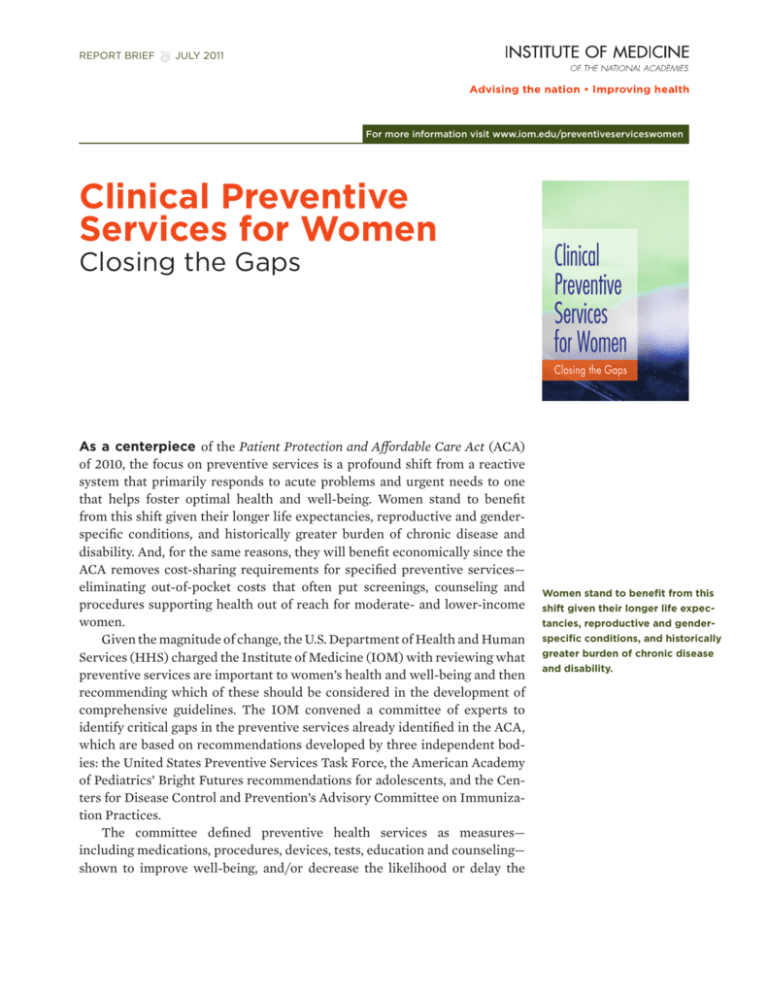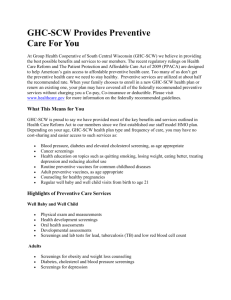
REPORT BRIEF JULY 2011
For more information visit www.iom.edu/preventiveserviceswomen
Clinical Preventive
Services for Women
Closing the Gaps
As a centerpiece of the Patient Protection and Affordable Care Act (ACA)
of 2010, the focus on preventive services is a profound shift from a reactive
system that primarily responds to acute problems and urgent needs to one
that helps foster optimal health and well-being. Women stand to benefit
from this shift given their longer life expectancies, reproductive and genderspecific conditions, and historically greater burden of chronic disease and
disability. And, for the same reasons, they will benefit economically since the
ACA removes cost-sharing requirements for specified preventive services—
eliminating out-of-pocket costs that often put screenings, counseling and
procedures supporting health out of reach for moderate- and lower-income
women.
Given the magnitude of change, the U.S. Department of Health and Human
Services (HHS) charged the Institute of Medicine (IOM) with reviewing what
preventive services are important to women’s health and well-being and then
recommending which of these should be considered in the development of
comprehensive guidelines. The IOM convened a committee of experts to
identify critical gaps in the preventive services already identified in the ACA,
which are based on recommendations developed by three independent bodies: the United States Preventive Services Task Force, the American Academy
of Pediatrics’ Bright Futures recommendations for adolescents, and the Centers for Disease Control and Prevention’s Advisory Committee on Immunization Practices.
The committee defined preventive health services as measures—
including medications, procedures, devices, tests, education and counseling—
shown to improve well-being, and/or decrease the likelihood or delay the
Women stand to benefit from this
shift given their longer life expectancies, reproductive and genderspecific conditions, and historically
greater burden of chronic disease
and disability.
onset of a targeted disease or condition. To guide
its deliberations in determining gaps in preventive
services not included in existing guidelines, the
committee developed four overarching questions:
ventive services and screenings that support
women’s overall health.
For sexually active women, the committee
found that current recommendations of screening for cervical cancer, counseling for sexually
transmitted infections, and HIV counseling and
screening are too limited in scope and should be
expanded. It also made several recommendations
that support women’s reproductive health. These
include a fuller range of contraceptive education,
counseling, methods, and services so that women
can better avoid unwanted pregnancies and space
their pregnancies to promote optimal birth outcomes. Additional recommendations address
needs of pregnant women, including screening
for gestational diabetes and lactation counseling
and equipment to help women who choose to
breastfeed do so successfully.
The committee recommended including at
least one well-woman preventive care visit annually for women to receive comprehensive services.
Depending on a woman’s health status, health
needs, and risk factors, multiple visits might be
recommended to provide the full range of preventive services.
Finally, the committee recommended that
all women and adolescent girls be screened and
counseled for interpersonal and domestic violence
in a culturally sensitive and supportive manner.
An estimated five million women are physically,
sexually, or emotionally abused by their partners
each year in the United States. Screening for risk
of abuse is central to women’s safety, as well as to
addressing current health concerns and preventing future health problems.
• Are high-quality systematic evidence
reviews available which indicate that the
service is effective in women?
• Are quality peer-reviewed studies available
demonstrating effectiveness of the service
in women?
• Has the measure been identified as a federal
priority to address in women’s preventive
services?
• Are there existing federal, state, or international practices, professional guidelines, or
federal reimbursement policies that support the use of the measure?
Preventive measures recommended by the
IOM committee for preventive coverage consideration met the following criteria:
• The condition to be prevented affects a
broad population;
• The condition to be prevented has a large
potential impact on health and well-being;
and
• The quality and strength of the evidence is
supportive.
The committee took seriously its task of focusing on women’s unique health needs. Throughout
the study process, the committee repeatedly questioned whether the disease or condition was significant to women and, especially, whether it was
more common or more serious in women than in
men or whether women experienced different
outcomes or benefited from different interventions than men.
Keeping Preventive Care Up-to-Date
The committee made several recommendations
that will enable HHS to periodically update the
review of preventive services covered under the
ACA. The committee recommends developing
the structures within HHS that involve accountability and processes to ensure that preventive
Protecting Women’s Health
The committee found sufficient evidence to
endorse eight recommendations for specific pre-
2
The committee defined
preventive health services as
measures—including medications,
procedures, devices, tests,
education and counseling—shown
to improve well-being, and/or
decrease the likelihood or delay
the onset of a targeted disease or
condition.
Recommendations for Preventive Health Care Services for Women that Should be Considered by the U.S.
Department of Health and Human Services
Recommendation 5.1: Screening for gestational diabetes in pregnant women between 24 and 28 weeks
of gestation and at the first prenatal visit for pregnant
women identified to be at high risk for diabetes.
Recommendation 5.6: Comprehensive lactation support and counseling and costs of renting breastfeeding
equipment. A trained provider should provide counseling services to all pregnant women and to those in the
postpartum period to ensure the successful initiation
and duration of breastfeeding. (The ACA ensures that
breastfeeding counseling is covered; however, the committee recognizes that interpretation of this varies.)
Recommendation 5.2: The addition of high-risk human
papillomavirus DNA testing in addition to conventional
cytology testing in women with normal cytology results.
Screening should begin at 30 years of age and should
occur no more frequently than every 3 years.
Recommendation 5.7: Screening and counseling for
interpersonal and domestic violence. Screening and
counseling involve elicitation of information from women and adolescents about current and past violence
and abuse in a culturally sensitive and supportive manner to address current health concerns about safety
and other current or future health problems.
Recommendation 5.3: Annual counseling on sexually
transmitted infections for all sexually active women.
Recommendation 5.8: At least one well-woman preventive care visit annually for adult women to obtain
the recommended preventive services, including
preconception and prenatal care. The committee also
recognizes that several visits may be needed to obtain
all necessary recommended preventive services, depending on a woman’s health status, health needs, and
other risk factors.
Recommendation 5.4: Counseling and screening for
human immunodeficiency virus infection on an annual
basis for sexually active women.
Recommendation 5.5: The full range of Food and
Drug Administration-approved contraceptive methods, sterilization procedures, and patient education
and counseling for all women with reproductive
capacity.
3
Committee on Preventive Services for Women
Linda Rosenstock (Chair)
Dean, School of Public Health,
University of California, Los
Angeles
Alfred O. Berg
Professor, Department of
Family Medicine, University of
Washington School of Medicine, Seattle
Claire D. Brindis
Professor of Pediatrics and
Health Policy, Department of
Pediatrics and Department of
Obstetrics, Gynecology and
Reproductive Health Services,
and Director, Philip R. Lee Institute for Health Policy Studies,
School of Medicine, University
of California, San Francisco
Angela Diaz
Jean C. and James W. Crystal
Professor of Adolescent Health,
Department of Pediatrics
and Community Preventative
Medicine, Mount Sinai Medical
Center, New York
Francisco Garcia
Distinguished Outreach Professor of Public Health, and
Obstetrics and Gynecology;
Director, University of Arizona
Center of Excellence in Women’s Health; and Codirector of
the Cancer Disparities Institute,
University of Arizona, Tucson
Kimberly Gregory
Vice Chair of Women’s Healthcare Quality and Performance
Improvement, and Department
of Obstetrics and Gynecology,
Cedars-Sinai Medical Center,
Los Angeles
Paula A. Johnson
Executive Director, Connors
Center for Women’s Health
and Gender Biology, and Chief,
Division of Women’s Health,
Brigham and Women’s Hospital, Boston
Anthony Lo Sasso
Professor and Senior Research
Scientist, Division of Health
Policy and Administration,
University of Illinois at Chicago
School of Public Health
Heidi D. Nelson
Research Professor of Medical
Informatics and Clinical Epidemiology and Medicine, Oregon
Health and Science University,
and Medical Director for Cancer Prevention and Screening,
Providence Cancer Center,
Providence Health & Services,
Portland
Roberta B. Ness
Dean and M. David Low Chair
in Public Health, School of Public Health, University of Texas,
Houston
Magda G. Peck
Professor of Public Health and
Pediatrics and Associate Dean
for Community Engagement
and Public Health Practice,
College of Public Health,
University of Nebraska Medical
Centers, Omaha
E. Albert Reece
Vice President for Medical
Affairs, University of Maryland,
and John Z. and Akiko K. Bowers Distinguished Professor and
Dean, University of Maryland
School of Medicine, Baltimore
Alina Salganicoff
Vice President and Director,
Women’s Health Policy, Henry
J. Kaiser Family Foundation,
Menlo Park, California
Sally W. Vernon
Division Director, Health
Promotion and Behavioral
Sciences, Blair Justice, Ph.D.
Professorship in Mind-Body
Medicine and Public Health,
and Professor of Epidemiology and Behavioral Sciences,
University of Texas School of
Public Health, Houston
Carol S. Weisman
Distinguished Professor of
Public Health Sciences and
Obstetrics and Gynecology
and Associate Dean for Faculty
Affairs, Pennsylvania State College of Medicine, Hershey
services meeting the requisite criteria will be considered in the future, as science emerges. Further,
HHS should establish an independent commission
to support the process.
The committee noted that the public health
system and community-based preventive services
are important to achieving the aims of preventive
health services. Community-based health services
can play significant roles in providing preventive
care to many different populations. The committee encourages HHS to consider widening the
proposed commission’s scope of authority so that
public health efforts work in coordination with
the new and existing bodies that are charged with
overseeing other elements of the ACA.
Conclusion
Positioning preventive care as the foundation of
the U.S. healthcare system is critical to ensuring
Americans’ health and well-being. Although the
ACA addresses preventive services for both men
and women of all ages, women particularly stand
to benefit from additional preventive health services. The inclusion of evidence-based screenings,
counseling and procedures that address women’s
greater need for services over the course of a lifetime may have a profound impact for individuals
and the nation as a whole. f
Jeanette H. Magnus
Cecile Usdin Professor in
Women’s Health and Chair, Department of Community Health
Sciences, School of Public
Health and Tropical Medicine,
Tulane University, New Orleans
Study Staff
Karen Helsing
Study Director
Amy Pryzbocki
Financial Associate
Jesse Flynn
Associate Program Officer
Rose Marie Martinez
Director, Board on Population Health and Public Health
Practice
Suzanne Landi
Research Assistant
Chelsea Frakes
Senior Program Assistant
Rebekah E. Gee
Institute of Medicine
Anniversary Fellow
Study Sponsor
The Department of Health and Human Services
500 Fifth Street, NW
Washington, DC 20001
TEL 202.334.2352
FAX 202.334.1412
www.iom.edu
The Institute of Medicine serves as adviser to the nation to improve health.
Established in 1970 under the charter of the National Academy of Sciences,
the Institute of Medicine provides independent, objective, evidence-based advice
to policy makers, health professionals, the private sector, and the public.
Copyright 2011 by the National Academy of Sciences. All rights reserved.







